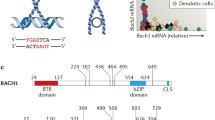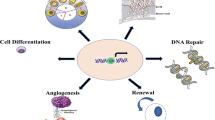Abstract
Activating transcription factor 3 (ATF3) is a member of the ATF/cyclic AMP response element-binding (ATF/CREB) family of transcription factors. It is an adaptive-response gene that participates in cellular processes to adapt to extra- and/or intracellular changes, where it transduces signals from various receptors to activate or repress gene expression. Advances made in understanding the immunobiology of Toll-like receptors have recently generated new momentum for the study of ATF3 in immunity. Moreover, the role of ATF3 in the regulation of the cell cycle and apoptosis has important implications for understanding susceptibility to and progression of several cancers.

Similar content being viewed by others
References
Hai T (2006) The ATF transcription factors in cellular adaptive responses. In: Ma J (ed) Gene expression and regulation. Higher Education Press, Beijing, China, pp 322–333
Montminy MR, Bilezikjian LM (1987) Binding of a nuclear protein to the cyclic-AMP response element of the somatostatin gene. Nature 328:175–178
Deutsch PJ, Hoeffler JP, Jameson JL, Lin JC, Habener JF (1988) Structural determinants for transcriptional activation by cAMP-responsive DNA elements. J Biol Chem 263:18466–18472
Hai T, Liu F, Coukos WJ, Green MR (1989) Transcription factor ATF cDNA clones: an extensive family of leucine zipper proteins able to selectively form DNA-binding heterodimers. Genes Dev 3:2083–2090
Chen BP, Liang G, Whelan J, Hai T (1994) ATF3 and ATF3 ∆ Zip: transcriptional repression versus activation by alternatively spliced isoforms. J Biol Chem 269:15819–15826
Hai T, Curran T (1991) Cross-family dimerization of transcription factors Fos/Jun and ATF/CREB alters DNA binding specificity. Proc Natl Acad Sci USA 88:3720–3724
Hsu JC, Laz T, Mohn KL, Taub R (1991) Identification of LRF-1, a leucine-zipper protein that is rapidly and highly induced in regenerating liver. Proc Natl Acad Sci USA 88:3511–3515
Hsu JC, Bravo R, Taub R (1992) Interactions among LRF-1, JunB, c-Jun, and c-Fos define a regulatory program in the G1 phase of liver regeneration. Mol Cell Biol 12:4654–4665
Chu HM, Tan Y, Kobierski LA, Balsam LB, Comb MJ (1994) Activating transcription factor-3 stimulates 3′, 5′-cyclic adenosine monophosphate-dependent gene expression. Mol Endocrinol 8:59–68
Fawcett TW, Martindale JL, Guyton KZ, Hai T, Holbrook NJ (1999) Complexes containing activating transcription factor (ATF)/cAMP-responsive-element-binding protein (CREB) interact with the CCAAT/enhancer-binding protein (C/EBP)-ATF composite site to regulate Gadd153 expression during the stress response. Biochem J 339(Pt 1):135–141
Nilsson M, Toftgard R, Bohm S (1995) Activated Ha-Ras but not TPA induces transcription through binding sites for activating transcription factor 3/Jun and a novel nuclear factor. J Biol Chem 270:12210–12218
Hai T, Wolfgang CD, Marsee DK, Allen AE, Sivaprasad U (1999) ATF3 and stress responses. Gene Expr 7:321–335
Lu D, Wolfgang CD, Hai T (2006) Activating transcription factor 3, a stress-inducible gene, suppresses Ras-stimulated tumorigenesis. J Biol Chem 281:10473–10481
Kawai T, Akira S (2006) TLR signaling. Cell Death Differ 13:816–825
Swann JB, Vesely MD, Silva A, Sharkey J, Akira S, Schreiber RD, Smyth MJ (2008) Demonstration of inflammation-induced cancer and cancer immunoediting during primary tumorigenesis. Proc Natl Acad Sci USA 105:652–656
Rakoff-Nahoum S, Medzhitov R (2007) Regulation of spontaneous intestinal tumorigenesis through the adaptor protein MyD88. Science 317:124–127
Leitner WW, Hwang LN, DeVeer MJ, Zhou A, Silverman RH, Williams BRG, Dubensky TW, Ying H, Restifo NP (2003) Alphavirus-based DNA vaccine breaks immunological tolerance by activating innate antiviral pathways. Nat Med 9:33–39
Scheule RK (2000) The role of CpG motifs in immunostimulation and gene therapy. Adv Drug Deliv Rev 44:119–134
McCluskie MJ, Weeratna RD, Davis HL (2000) The role of CpG in DNA vaccines. Springer Semin Immunopathol 22:125–132
Whitmore MM, DeVeer MJ, Edling A, Oates RK, Simons B, Lindner D, Williams BRG (2004) Synergistic activation of innate immunity by double-stranded RNA and CpG DNA promotes enhanced antitumour activity. Cancer Res 64:5850–5860
Whitmore MM, Iparraguirre A, Kubelka L, Weninger W, Hai T, Williams BRG (2007) Negative regulation of TLR-signaling pathways by activating transcription factor-3. J Immunol 179:3622–3630
Gilchrist M, Thorsson V, Li B, Rust AG, Korb M, Kennedy K, Hai T, Bolouri H, Aderem A (2006) Systems biology approaches identify ATF3 as a negative regulator of Toll-like receptor 4. Nature 441:173–178
Litvak V, Ramsey SA, Rust AG, Zak DE, Kennedy K, Lampano AE, Nykter M, Shmulevich I, Aderem A (2009) Function of C/EBPδ in a regulatory circuit that discriminates between transient and persistent TLR4-induced signals. Nat Immunol 10:437–443
Hartman MG, Lu D, Kim ML, Kociba GJ, Shukri T, Buteau J, Wang X, Frankel WL, Guttridge D, Prentki M, Grey ST, Ron D, Hai T (2004) Role for activating transcription factor 3 in stress-induced beta-cell apoptosis. Mol Cell Biol 24:5721–5732
Gilchrist M, Henderson WR Jr, Clark AE, Simmons RM, Ye X, Smith KD, Aderem A (2008) Activating transcription factor 3 is a negative regulator of allergic pulmonary inflammation. J Exp Med 205:2349–2357
Khuu CH, Barrozo RB, Hai T, Weinstein SL (2007) Activating transcription factor 3 (ATF3) represses the expression of CCL4 in murine macrophages. Mol Immunol 44:1598–1605
Rosenberger CM, Clark AE, Treuting PM, Johnson CD, Aderem A (2008) ATF3 regulates MCMV infection in mice by modulating IFN-γ expression in natural killer cells. Proc Natl Acad Sci USA 105:2544–2549
Yin X, DeWille JW, Hai T (2008) A potential dichotomous role of ATF3, an adaptive-response gene, in cancer development. Oncogene 27:2118–2127
Pelzer AE, Bektic J, Haag P, Berger AP, Pycha A, Schäfer G, Rogatsch H, Horninger W, Bartsch G, Klocker H (2006) The expression of transcription factor activating transcription factor 3 in the human prostate and its regulation by androgen in prostate cancer. J Urol 175:1517–1522
Janz M, Hummel M, Truss M, Wollert-Wulf B, Mathas S, Jöhrens K, Hagemeier C, Bommert K, Stein H, Dörken D, Bargou RC (2006) Classical Hodgkin lymphoma is characterized by high constitutive expression of activating transcription factor 3 (ATF3), which promotes viability of Hodgkin/Reed-Sternberg cells. Blood 107:2536–2539
Bandyopadhyay S, Wang Y, Zhan R, Pai SK, Watabe M, Iiizumi M, Furuta E, Mohinta S, Liu W, Horita S, Hosobe S, Tsikada T, Miura K, Takano Y, Saito K, Commes T, Piquemal D, Hai T, Watabe K (2006) The tumor metastatis suppressor gene Drg-1 down-regulates the expression of activating transcription factor 3 in prostate cancer. Cancer Res 66:11983–11990
Ishiguro T, Nagawa H, Naito M, Tsuruo T (2000) Inhibitory effect of ATF3 antisense oligonucleotide on ectopic growth of HT29 human colon cancer cells. Jpn J Cancer Res 91:833–836
Zinszner H, Kuroda M, Wang X, Batchvarova N, Lightfoot RT, Remotti H, Stevens JL, Ron D (1998) CHOP is implicated in programmed cell death in response to impaired function of the endoplasmic reticulum. Genes Dev 12:982–995
Maytin EV, Ubeda M, Lin JC, Habener JF (2001) Stress-inducible transcription factor CHOP/gadd153 induces apoptosis in mammalian cells via p38 kinase-dependent and -independent mechanisms. Exp Cell Res 267:193–204
Kim R, Ohi Y, Inoue H, Aogi K, Toge T (1999) Introduction of gadd153 gene into gastric cancer cells can modulate sensitivity to anticancer agents in association with apoptosis. Anticancer Res 19:1779–1783
Scott DW, Loo G (2004) Curcumin-induced GADD153 gene up-regulation in human colon cancer cells. Carcinogenesis 25:2155–2164
Wolfgang CD, Chen BP, Martindale JL, Holbrook NJ, Hai T (1997) gadd153/Chop10, a potential target gene of the transcriptional repressor ATF3. Mol Cell Biol 17:6700–6707
Bottone FG Jr, Martinez JM, Collins JB, Afshari CA, Eling TE (2003) Gene modulation by the cyclooxygenase inhibitor, sulindac sulfide, in human colorectal carcinoma cells: possible link to apoptosis. J Biol Chem 278:25790–25801
Huang X, Li X, Guo B (2008) KLF6 induces apoptosis in prostate cancer cells through up-regulation of ATF3. J Biol Chem 283:29795–29801
Bottone FG Jr, Moon Y, Kim JS, Alston-Mills B, Ishibashi M, Eling TE (2005) The anti-invasive activity of cyclooxygenase inhibitors is regulated by the transcription factor ATF3 (activating transcription factor 3). Mol Cancer Ther 4:693–703
Syed V, Mukherjee K, Lyons-Weiler J, Lau KM, Mashima T, Tsuruo T, Ho SM (2005) Identification of ATF-3, caveolin-1, DLC-1, and NM23–H2 as putative antitumorigenic, progesterone-regulated genes for ovarian cancer cells by gene profiling. Oncogene 24:1774–1787
Kang Y, Chen CR, Massague J (2003) A self-enabling TGFbeta response coupled to stress signaling: Smad engages stress response factor ATF3 for Id1 repression in epithelial cells. Mol Cell 11:915–926
Ling MT, Wang X, Zhang X, Wong YC (2006) The multiple roles of Id-1 in cancer progression. Differentiation 74:481–487
Yan C, Jamaluddin MS, Aggarwal B, Myers J, Boyd DD (2005) Gene expression profiling identifies activating transcription factor 3 as a novel contributor to the proapoptotic effect of curcumin. Mol Cancer Ther 4:233–241
Yamaguchi K, Lee SH, Kim JS, Wimalasena J, Kitajima S, Baek SJ (2006) Activating transcription factor 3 and early growth response 1 are the novel targets of LY294002 in a phosphatidylinositol 3-kinase-independent pathway. Cancer Res 66:2376–2384
Wang A, Arantes S, Conti C, McArthur M, Aldaz CM, MacLeod MC (2007) Epidermal hyperplasia and oral carcinoma in mice overexpressing the transcription factor ATF3 in basal epithelial cells. Mol Carcinog 46:476–487
Wang A, Arantes S, Yan L, Kiguchi K, McArthur MJ, Sahin A, Thames HD, Aldaz CM, Macleod MC (2008) The transcription factor ATF3 acts as an oncogene in mouse mammary tumorigenesis. BMC Cancer 8:268
Li D, Yin X, Zmuda EJ, Wolford CC, Dong X, White MF, Hai T (2008) The repression of IRS2 gene by ATF3, a stress-inducible gene, contributes to pancreatic beta-cell apoptosis. Diabetes 57:635–644
Withers DJ, Gutierrez JS, Towery H, Burks DJ, Ren JM, Previs S, Zhang Y, Bernal D, Pons S, Shulman GI, Bonner-Weir S, White MF (1998) Disruption of IRS-2 causes type 2 diabetes in mice. Nature 391:900–904
Dearth RK, Cui X, Kim HJ, Hadsell DL, Lee AV (2007) Oncogenic transformation by the signaling adaptor proteins insulin receptor substrate (IRS)-1 and IRS-2. Cell Cycle 6:705–713
Knudsen KE, Diehl JA, Haiman CA, Knudsen ES (2006) Cyclin D1: polymorphism, aberrant splicing and cancer risk. Oncogene 25:1620–1628
Acknowledgements
This work was supported in part by a grant from the National Institutes of Health (P01 CA062220). MT was supported by a scholarship from the Australian Rotary Health Research Fund/Rotary District 9650 Bowelscan.
Conflict of interest statement
The authors declare that they have no conflict of interests.
Author information
Authors and Affiliations
Corresponding author
Rights and permissions
About this article
Cite this article
Thompson, M.R., Xu, D. & Williams, B.R.G. ATF3 transcription factor and its emerging roles in immunity and cancer. J Mol Med 87, 1053–1060 (2009). https://doi.org/10.1007/s00109-009-0520-x
Received:
Revised:
Accepted:
Published:
Issue Date:
DOI: https://doi.org/10.1007/s00109-009-0520-x




